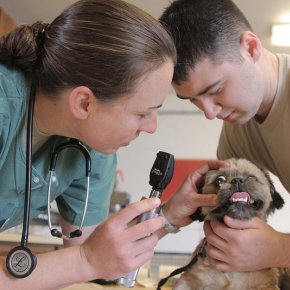Veterinarian Salary
How much do veterinarians make? The median annual veterinarian salary was $84,460, according to the US Bureau of Labor Statistics. The top ten percent of Veterinarians in the industry earned $144,100 or more, while the bottom ten percent earned $51,530 or less. In 2012, the average annual salary of a veterinarian working for the U.S. government was $85,170.
How To Become A Veterinarian
Are wondering how to become a vet? Aspiring veterinarians must complete the pre-requisite undergraduate courses necessary to gain acceptance into one of the 28 accredited veterinary programs in the United States. After completion of their 4 year veterinary sciences program, candidates must gain licensing in order to practice as a veterinarian.
How Long Does It Take To Become A Veterinarian?
The process of becoming a veterinarian takes a minimum of 7 years , though the average time is 8 years – 4 years to complete a bachelor’s degree and 4 years at a college of veterinary medicine.
Educational Requirements
Take Undergraduate Pre-Requisite Courses
While most students entering veterinary programs have bachelor’s degrees, it’s not strictly necessary. However, students must complete a number of pre-requisite undergraduate classes in subjects such as anatomy, biology, chemistry, microbiology, physiology, and zoology, in order to gain acceptance into a veterinary program. It takes a minimum of 3 years to complete the necessary pre-requisites. A full list of required course prerequisites is available at the AAVMC website. Note: Getting into veterinary programs is extremely competitive, and less than 50% of applicants are accepted.
Obtain A Doctor of Veterinary Medicine Degree (D.V.M or V.M.D.)
After gaining acceptance into one of the 28 accredited veterinary programs in the United States, students must 3 years of classroom, clinical, and lab work, along with 1 year doing clinical rotations, gaining hands on experience working with animals and interacting with their owners. Courses in a veterinary medicine program may include basic courses on animal anatomy and physiology, as well as more specialized courses on treating, diagnosing, and preventing diseases. Modern veterinary programs are also introducing business courses designed to help veterinarians learn to better manage and run a practice of their own.
Certification
Veterinarians aren’t required to have certification in order to practice. However, veterinarians in the U.S. can obtain certification from The American Veterinary Medical Association (AVMA), which provides veterinary certification in 40 specialties. Certification demonstrates exceptional expertise in a particular specialty. Veterinarians seeking certification must meet certain minimum qualifications, depending on the specialty. Usually this involves possessing a minimum of 3 years experience, as well as additional education and/or completion of a residency program.
Licensing
In order to work as Veterinarian in the United States, all vets must be licensed. Licensing requirements varies on a state by state basis, but the minimum requirements for all states are:
- The individual must have a degree from an accredited veterinary program
- The individual must pass the North American Veterinary Licensing Exam
Many states also require that the individual pass a local state exam, and vets looking to be licensed in another state will usually have to take the local state exam.
Veterinarian job description
What does a veterinarian do? Veterinarians are doctors who specialize in the care of animals. Like physicians do for humans, they diagnose and treat sick or injured animals. They also do regular inspection of animals - whether they be household pets, livestock, or zoo animals - to ensure their good health, and may also be involved in researching animal medical conditions. Most veterinarians work in clinics within the veterinary services industry. They perform most of their work on household pets and their practice is very similar to that of a physician. They examine animals that come in, they may look at the animal’s medical history, and they may order additional diagnostic tests or refer the animal to a specialist. An important part of a veterinarian's job in a veterinary services clinic is communicating with the animal's owners. Not all vets work with household pets. Other vets may work treating livestock, in which case they might travel to farms and slaughterhouses in order to perform their work. These vets may work with farm owners and government officials to ensure the health of local livestock, as well as compliance with local government regulations.
Duties
While a veterinarian’s duties will depend on their place of employment, the typical day in a veterinarian employed in a private clinic includes:
- Examining and diagnosing admitted animals
- Perform basic medical procedures such as setting broken bones, suturing wounds, administering antibiotics, or providing geriatric care for older animals.
- Prescribe medication for the animal
- Interacting with the animal’s owner
- Performing routine neutering/spaying
Job Outlook
Veterinarians have an excellent job outlook, with a predicted 12% job growth in the industry from 2012-2022. There were 70,300 veterinary positions in the United States in 2012, with that number expected to rise to 78,700 by 2022. The demand for veterinary care will continue to rise with a growing household pet population. The demand is also fueled by a rapidly growing global population and the need for livestock and food. There will be many employment opportunities opening up in the profession for those who work with livestock, disease control, and public health. Competition in veterinary medicine is limited by the fact that there are only 28 accredited veterinary programs nationally. Altogether, they only produce 2,500 graduates each year, ensuring that there will be plenty of demand for new veterinarians in the years to come.

 What Does A Veterinarian Do?
What Does A Veterinarian Do?
Leave a Reply